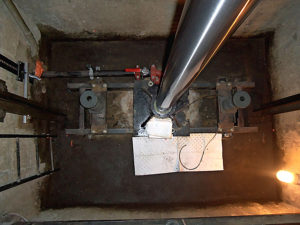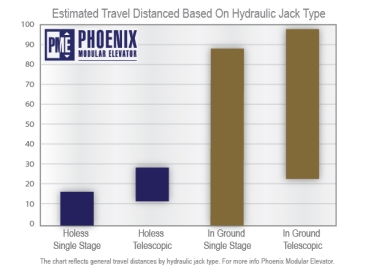Elevator Delays
October 12, 2017Passenger Elevator
October 18, 2017All About Elevator Jacks

When it comes to many elevator applications, especially for buildings between 2 and 5 stories, you will find a hydraulic elevator jacks are a common, yet crucial part of the system that drives the elevator up. As a matter of fact, approximately 70% of all elevators installed are hydraulic in nature and contain elevator jacks. The jacks are part of a system that includes hydraulic fluid, tanks, motors, and pumps with the jack being the final piece of the system. So, understanding the basics of the elevator jack is crucial if you are considering buying a new elevator or modernizing the elevator jacks in an existing elevator.
Depending on the system you have, the distance your elevator travels, and the space available, you have several options available. This article will explain the various types of jacks and the advantages and disadvantages associated with each.
→ Single Stage Holeless – Many times when new elevators are being placed, you can’t drill a hole in the bottom of the elevator pit or it is cost prohibitive to do so. Enter the holeless elevator jack. The most common jack used for short travel distances is the single-stage variety. A single stage means that it is one piston that goes up and down and it does not telescope when it reaches a certain height. These can be used for passenger or freight elevators.
The benefits of this type of jack (often called a twin-jack and used in tandem on either side of the elevator car) is that they are lighter and easier to put into place, are the most economical choice, and can be designed to carry very heavy loads. On the downside, because you are often dealing with two jacks, more adjustments must be made and it takes a bit more maintenance. Also, because the jacks commonly go on either side of the car, and there is no hole for the jacks to retreat in, there must be more space at the top of the hoistway above the car.
→ Single Stage In-Ground – This option is very common, especially when you can drill a hole in the bottom of the pit and want to travel multiple floors. Because it does not telescope, the moving parts are limited and it is, therefore, reliable. It has also been around for a very long time as a solution and has a solid track record.
The good things about a single stage in-ground jack is that it is easy to install, fairly economical, especially for mid-rise projects, has a huge capacity, and maintenance is limited to one jack. They also provide a very smooth ride. On the downside, the jack is in a hole. This can lead to leaks of hydraulic fluid into the underground water supply or contamination of the soil. Keep in mind that most of the contamination issues have been resolved with new technology and regulations. However, the threat remains: units can have a cracked PVC casing which can cause flooding of the pit and some fluid leakage. Also, old corroded sheaths that the jacks reside in need to be replaced, usually at a significant cost. Also, the depth of the jack must be equal to the travel of the elevator car. This can mean an expensive, deep hole.
→ Telescopic Jacks (Holeless and In-Ground) – Telescopic jacks can have up to four pistons, each traveling inside each other. These are used when a more compact solution is needed for either freight or passenger elevators. Telescopic jacks going in-ground will reduce the depth of the hole required, but can sometimes be more costly in and of themselves.

The big plus is that there is a reduced drilling cost for an in-ground application and a higher travel distance than for holeless projects. Also, the installation is usually fast as the jacks are compact and easy to handle. The disadvantages include the obvious; there are more moving parts, so initial set up may be more complicated (bleeding the jack completely, is required). Depending on overall travel distance, follower guides will be needed, requiring additional engineering. Long-term maintenance may be more costly, as well. Finally, there are simply more packing and seals due to multiple pistons.
Each of the above jacks have their place and purpose depending on travel distance, but, as you can see in the chart, there is overlap based solely the height the elevator needs to go to. Other factors include price, the ability to drill, and even personal preference (some feel the ride is better in elevators that have an in-ground jack).
The best way to determine the optimal option for your building project is to contact an elevator consultant or an unbiased company that can provide any type of elevator. They should welcome all your questions and be willing to break down all possibilities by price or other factors important to your project. If you would like to talk with us about elevator jacks, visit us here.



